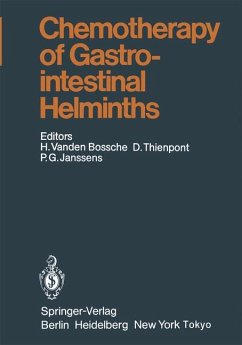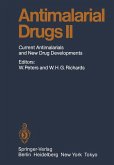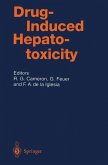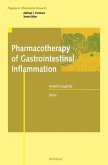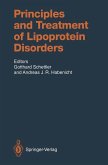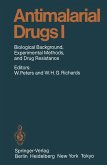Chemotherapy of Gastrointestinal Helminths
Herausgegeben:Vanden Bossche, H.; Thienpont, D.; Janssens, P.G.;Mitarbeit:Vanden Bossche, H.; Janssens, P.G.; Arundel, J.H.; Boersema, J.H.; Bruyning, C.F.A.; Cross, J.H.; Davis, A.; De Muynck, A.; Kamme
Chemotherapy of Gastrointestinal Helminths
Herausgegeben:Vanden Bossche, H.; Thienpont, D.; Janssens, P.G.;Mitarbeit:Vanden Bossche, H.; Janssens, P.G.; Arundel, J.H.; Boersema, J.H.; Bruyning, C.F.A.; Cross, J.H.; Davis, A.; De Muynck, A.; Kamme
- Broschiertes Buch
- Merkliste
- Auf die Merkliste
- Bewerten Bewerten
- Teilen
- Produkt teilen
- Produkterinnerung
- Produkterinnerung
Parasitic diseases are the most widespread of all the major diseases, currently 9 affecting about 3 x 10 people and innumerable domestic animals. There is no doubt that among these parasitic diseases, the helminthic infections of the gastrointestinal tract are about the most important because of their global distribution, their high prevalence, their effects on the nutritional status of men and animals, their effects on the physical and mental development of children, and their economic effects on the production of animals. Anthelmintics are important elements in the control of these…mehr
Andere Kunden interessierten sich auch für
![Gastrointestinal Regulatory Peptides Gastrointestinal Regulatory Peptides]() Gastrointestinal Regulatory Peptides77,99 €
Gastrointestinal Regulatory Peptides77,99 €![Experimental Production of Diseases Experimental Production of Diseases]() Experimental Production of Diseases77,99 €
Experimental Production of Diseases77,99 €![Antimalarial Drug II Antimalarial Drug II]() Antimalarial Drug II115,99 €
Antimalarial Drug II115,99 €![Drug-Induced Hepatotoxicity Drug-Induced Hepatotoxicity]() Drug-Induced Hepatotoxicity78,99 €
Drug-Induced Hepatotoxicity78,99 €![Pharmacotherapy of Gastrointestinal Inflammation Pharmacotherapy of Gastrointestinal Inflammation]() Antonio Guglietta (ed.)Pharmacotherapy of Gastrointestinal Inflammation106,99 €
Antonio Guglietta (ed.)Pharmacotherapy of Gastrointestinal Inflammation106,99 €![Principles and Treatment of Lipoprotein Disorders Principles and Treatment of Lipoprotein Disorders]() Principles and Treatment of Lipoprotein Disorders75,99 €
Principles and Treatment of Lipoprotein Disorders75,99 €![Antimalarial Drugs I Antimalarial Drugs I]() Antimalarial Drugs I77,99 €
Antimalarial Drugs I77,99 €-
-
-
Parasitic diseases are the most widespread of all the major diseases, currently 9 affecting about 3 x 10 people and innumerable domestic animals. There is no doubt that among these parasitic diseases, the helminthic infections of the gastrointestinal tract are about the most important because of their global distribution, their high prevalence, their effects on the nutritional status of men and animals, their effects on the physical and mental development of children, and their economic effects on the production of animals. Anthelmintics are important elements in the control of these gastrointestinal helminthic infections. In this volume the editors and authors have tried to find a way through the immense amount of information on anthelmintic drugs that is scattered throughout the literature. Different authors have critically examined this information from different angles. However, the aim of all has been to provide the information needed by veterinarians, physicians, and publichealth workers to select the most suitable drug for a given situation.
Produktdetails
- Produktdetails
- Handbook of Experimental Pharmacology 77
- Verlag: Springer / Springer Berlin Heidelberg / Springer, Berlin
- Softcover reprint of the original 1st ed. 1985
- Seitenzahl: 748
- Erscheinungstermin: 6. Dezember 2011
- Englisch
- Abmessung: 244mm x 170mm x 40mm
- Gewicht: 1265g
- ISBN-13: 9783642695292
- ISBN-10: 3642695299
- Artikelnr.: 36113754
- Herstellerkennzeichnung
- Springer-Verlag GmbH
- Tiergartenstr. 17
- 69121 Heidelberg
- ProductSafety@springernature.com
- Handbook of Experimental Pharmacology 77
- Verlag: Springer / Springer Berlin Heidelberg / Springer, Berlin
- Softcover reprint of the original 1st ed. 1985
- Seitenzahl: 748
- Erscheinungstermin: 6. Dezember 2011
- Englisch
- Abmessung: 244mm x 170mm x 40mm
- Gewicht: 1265g
- ISBN-13: 9783642695292
- ISBN-10: 3642695299
- Artikelnr.: 36113754
- Herstellerkennzeichnung
- Springer-Verlag GmbH
- Tiergartenstr. 17
- 69121 Heidelberg
- ProductSafety@springernature.com
1 Introduction.- A. Pathogenic Mechanisms in Man.- B. Modes of Transmission.- C. Clinical Sequelae of Infection.- D. Epidemiological Considerations.- E. Chemotherapy.- F. Conclusion.- References.- 2 Epidemiology of Gastrointestinal Helminths in Human Populations.- A. Introduction.- B. Epidemiological or "Mathematical" Models and Control.- C. Nematodes.- D. Trematodes.- E. Cestodes.- References.- 3 Epidemiology and Control of Gastrointestinal Helminths in Domestic Animals.- A. Introduction.- B. Spontaneous Regulation of Worm Burdens in the Host.- C. The Free-Living Stages.- D. Epidemiology of Gastrointestinal Nematode Infections.- E. The Control of Gastrointestinal Nematode Infections of Sheep and Cattle.- F. Conclusions.- References.- 4 Pharmacology of Anthelmintics.- A. Introduction.- B. Albendazole.- C. Amoscanate.- D. Amidantel.- E. Avermectins.- F. Bephenium Hydroxynaphthoate.- G. Bithionol.- H. Bitoscanate.- I. Bromoxanide.- J. Brotianide.- K. Cambendazole.- L. Ciclobendazole.- M. Closantel.- N. Dichlorophen.- O. Diphetarsone.- P. Disophenol.- Q. Febantel.- R. Fenbendazole.- S. Flubendazole.- T. Levamisole and Tetramisole.- U. Mebendazole.- V. Metrifonate.- W. Morantel.- X. Niclosamide.- Y. Oxantel.- Z. Oxfendazole.- AA. Oxibendazole.- BB. Parbendazole.- CC. Paromomycin.- DD. Piperazine.- EE. Praziquantel.- FF. Pyrantel.- GG. Pyrvinium Pamoate.- HH. Rafoxanide.- II. Tetrachloroethylene.- JJ. Tiabendazole.- KK. Thiophanate.- References.- 5 Chemotherapy of Gastrointestinal Nematodiasis in Man.- A. Introduction.- B. Ancylostomiasis.- C. Anisakiasis.- D. Ascariasis.- E. Enterobiasis.- F. Gnathostomiasis.- G. Intestinal Angiostrongyliasis.- H. Intestinal Capillariasis.- J. Oesophagostomiasis.- K. Strongyloidiasis.- L. Ternidens or False Hookworm Infection.- M.Trichinosis.- N. Trichostrongyliasis.- O. Trichuriasis.- References.- 6 Chemotherapy of Gastrointestinal Nematodiasis in Ruminants.- A. Introduction.- B. Factors and Circumstances Influencing the Choice of Anthelmintic.- C. The Anthelmintics.- References.- 7 Chemotherapy of Gastrointestinal Nematodiasis in Equines.- A. Introduction.- B. Strongylidae.- C. Other Important Nematodes.- D. Anthelmintics.- E. Conclusions.- References.- 8 Chemotherapy of Gastrointestinal Nematodiasis in Pigs.- A. Introduction.- B. Pig Nematodes.- C. Pen Hygiene and Pasture Management.- D. Herd Deworming.- E. Anthelmintics.- References.- 9 Chemotherapy of Gastrointestinal Nematodiasis in Carnivores.- A. Introduction.- B. Gastrointestinal Nematodes of Dogs and Cats.- C. Prevention and Treatment.- D. Older and Superseded Anthelmintics.- E. Organophosphates.- F. Tetrahydropyrimidines.- G. Imidazothiazoles.- H. Nitroscanate.- J. Benzimidazoles.- K. Avermectins.- L. Ticarbodine.- M. Tioxidazole.- N. Conclusions.- References.- 10 Chemotherapy of Gastrointestinal Nematodiasis in Birds.- A. Introduction.- B. Nematodes in Domestic Birds.- C. General Remarks.- D. The Anthelmintics.- References.- 11 Chemotherapy of Intestinal Trematodiasis in Mammals and Birds.- A. Introduction.- B. Intestinal Trematodes of Mammals.- C. Intestinal Trematodes of Birds.- D. Chemotherapeutic Agents.- References.- 12 Chemotherapy of Intestinal Trematodiasis in Man.- A. Introduction.- B. Fasciolopsiasis.- C. Heterophyidiasis.- D. Echinostomatidiasis.- E. Gastrodisciasis.- F. Lecithodendriidiasis.- G. Other Human Intestinal Trematodiasis.- H. Comment.- References.- 13 Chemotherapy of Tapeworm Infections in Animals.- A. Introduction.- B. Cestodes of Veterinary Importance.- C. Chemotherapeutic Agents.- D. Recommended Treatmentsfor Cestode Infections.- References.- 14 Chemotherapy of Tapeworm Infections in Man.- A. Introduction.- B. General Features of Human Cestode Infections.- C. Niclosamide.- D. Mebendazole.- E. Praziquantel.- F. Summary.- References.- 15 Mass Treatment.- A. Introduction.- B. Epidemiology.- C. A Mass Treatment Campaign.- D. Alternative Control Measures.- E. Conclusion.- Appendix A: Questionnaire.- Appendix B: Stool Examination.- Appendix C: Clinical Examination.- Appendix D: Instructions for the File.- References.- List of International Nonproprietary United States Adopted and Trade Names of Some Anthelmintics.
1 Introduction.- A. Pathogenic Mechanisms in Man.- B. Modes of Transmission.- C. Clinical Sequelae of Infection.- D. Epidemiological Considerations.- E. Chemotherapy.- F. Conclusion.- References.- 2 Epidemiology of Gastrointestinal Helminths in Human Populations.- A. Introduction.- B. Epidemiological or "Mathematical" Models and Control.- C. Nematodes.- D. Trematodes.- E. Cestodes.- References.- 3 Epidemiology and Control of Gastrointestinal Helminths in Domestic Animals.- A. Introduction.- B. Spontaneous Regulation of Worm Burdens in the Host.- C. The Free-Living Stages.- D. Epidemiology of Gastrointestinal Nematode Infections.- E. The Control of Gastrointestinal Nematode Infections of Sheep and Cattle.- F. Conclusions.- References.- 4 Pharmacology of Anthelmintics.- A. Introduction.- B. Albendazole.- C. Amoscanate.- D. Amidantel.- E. Avermectins.- F. Bephenium Hydroxynaphthoate.- G. Bithionol.- H. Bitoscanate.- I. Bromoxanide.- J. Brotianide.- K. Cambendazole.- L. Ciclobendazole.- M. Closantel.- N. Dichlorophen.- O. Diphetarsone.- P. Disophenol.- Q. Febantel.- R. Fenbendazole.- S. Flubendazole.- T. Levamisole and Tetramisole.- U. Mebendazole.- V. Metrifonate.- W. Morantel.- X. Niclosamide.- Y. Oxantel.- Z. Oxfendazole.- AA. Oxibendazole.- BB. Parbendazole.- CC. Paromomycin.- DD. Piperazine.- EE. Praziquantel.- FF. Pyrantel.- GG. Pyrvinium Pamoate.- HH. Rafoxanide.- II. Tetrachloroethylene.- JJ. Tiabendazole.- KK. Thiophanate.- References.- 5 Chemotherapy of Gastrointestinal Nematodiasis in Man.- A. Introduction.- B. Ancylostomiasis.- C. Anisakiasis.- D. Ascariasis.- E. Enterobiasis.- F. Gnathostomiasis.- G. Intestinal Angiostrongyliasis.- H. Intestinal Capillariasis.- J. Oesophagostomiasis.- K. Strongyloidiasis.- L. Ternidens or False Hookworm Infection.- M.Trichinosis.- N. Trichostrongyliasis.- O. Trichuriasis.- References.- 6 Chemotherapy of Gastrointestinal Nematodiasis in Ruminants.- A. Introduction.- B. Factors and Circumstances Influencing the Choice of Anthelmintic.- C. The Anthelmintics.- References.- 7 Chemotherapy of Gastrointestinal Nematodiasis in Equines.- A. Introduction.- B. Strongylidae.- C. Other Important Nematodes.- D. Anthelmintics.- E. Conclusions.- References.- 8 Chemotherapy of Gastrointestinal Nematodiasis in Pigs.- A. Introduction.- B. Pig Nematodes.- C. Pen Hygiene and Pasture Management.- D. Herd Deworming.- E. Anthelmintics.- References.- 9 Chemotherapy of Gastrointestinal Nematodiasis in Carnivores.- A. Introduction.- B. Gastrointestinal Nematodes of Dogs and Cats.- C. Prevention and Treatment.- D. Older and Superseded Anthelmintics.- E. Organophosphates.- F. Tetrahydropyrimidines.- G. Imidazothiazoles.- H. Nitroscanate.- J. Benzimidazoles.- K. Avermectins.- L. Ticarbodine.- M. Tioxidazole.- N. Conclusions.- References.- 10 Chemotherapy of Gastrointestinal Nematodiasis in Birds.- A. Introduction.- B. Nematodes in Domestic Birds.- C. General Remarks.- D. The Anthelmintics.- References.- 11 Chemotherapy of Intestinal Trematodiasis in Mammals and Birds.- A. Introduction.- B. Intestinal Trematodes of Mammals.- C. Intestinal Trematodes of Birds.- D. Chemotherapeutic Agents.- References.- 12 Chemotherapy of Intestinal Trematodiasis in Man.- A. Introduction.- B. Fasciolopsiasis.- C. Heterophyidiasis.- D. Echinostomatidiasis.- E. Gastrodisciasis.- F. Lecithodendriidiasis.- G. Other Human Intestinal Trematodiasis.- H. Comment.- References.- 13 Chemotherapy of Tapeworm Infections in Animals.- A. Introduction.- B. Cestodes of Veterinary Importance.- C. Chemotherapeutic Agents.- D. Recommended Treatmentsfor Cestode Infections.- References.- 14 Chemotherapy of Tapeworm Infections in Man.- A. Introduction.- B. General Features of Human Cestode Infections.- C. Niclosamide.- D. Mebendazole.- E. Praziquantel.- F. Summary.- References.- 15 Mass Treatment.- A. Introduction.- B. Epidemiology.- C. A Mass Treatment Campaign.- D. Alternative Control Measures.- E. Conclusion.- Appendix A: Questionnaire.- Appendix B: Stool Examination.- Appendix C: Clinical Examination.- Appendix D: Instructions for the File.- References.- List of International Nonproprietary United States Adopted and Trade Names of Some Anthelmintics.

